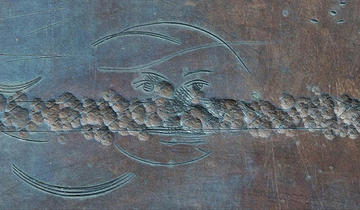William Blake’s Earliest Etchings uncovered

The Bodleian Libraries are announcing the discovery of previously unknown engravings on the reverse of a series of copper plates, which are thought to be the earliest engravings by the poet and artist William Blake.
The engravings, some of which are invisible to the naked eye, were discovered using the Bodleian Libraries’ innovative high-resolution scanning technology ARCHiOx, created in partnership with the Factum Foundation, which is able to scan the surface of objects at over one-million pixels per square inch.
Mark Crosby, Associate Professor of Literature at Kansas State University and a fellow of the Society of Antiquaries, worked with ARCHiOx’s Selene Photometric Stereo System to reveal compelling new evidence on the plates alongside consulting materials in the Bodleian’s archives. Collectively, this evidence suggests that these engravings can be attributed to an apprentice at the studio of master engraver James Basire, who would most likely have been the young Blake. If it is indeed the work of William Blake, these engravings reveal previously unknown insights into the artistic and technical development of the artist at the very outset of his career.
Attributed to the studio of James Basire, the plates were part of a series engraved during the 1770s, coinciding with William Blake’s apprenticeship to Basire from 1772 to 1779, a period in which Basire only apprenticed two young engravers. The plates were created to illustrate the antiquarian Richard Gough’s self-published book Sepulchral Monuments in Great Britain (1786-1796), with Gough commissioning Basire’s studio to engrave illustrated reproductions of significant mediaeval tombs across the UK, including the royal tombs in Westminster Abbey. These plates were bequeathed to the Bodleian Libraries after Gough’s death in 1809.
Among the engravings discovered on the reverse of the plates are a series of hatching, cross hatching, semi-circles and motifs made with burins and dry point compasses, all of which are suggestive of an apprentice honing their craft and emulating Basire’s house style. These engravings would never have been intended for printing, instead serving as a practice space for an apprentice to learn basic linear markings.
Amongst the most remarkable discoveries are engraved drawings which are suggestive of youthful doodles rather than technical exercises. Scans have revealed in incredible detail an engraved miniature face, consisting of two eyes, a partial nose and lips made up of the very pictorial elements practised elsewhere on the plates. The face was impossible to view with the naked eye due to extensive repoussage which has warped the plate. Elsewhere, the O in a plate maker's mark reading “LONDON” is neatly hatched in a fashion reminiscent of youthful colouring in.
Another uncovered motif is a short-shafted arrow, approximately 18mm in length and etched into the plate with a burin. Similar arrows or darts frequently occur as pictorial or textual motifs in Blake’s work, appearing significantly in two of his watercolour paintings of Milton’s Paradise Lost, suggesting that even in the work of the young Blake we can find an indication of the art and poetry he would produce later in his career.
Mark Crosby, Associate Professor of Literature at Kansas State University, said: "These doodles reveal personal, intimate moments that were not intended to be seen by anyone other than the artist. For the first time since they were made, we can now see the practice work and doodling of the young apprentice responsible for, amongst other things, the tiny visionary face that emerges from the copperplate to return our gaze across two and half centuries."
